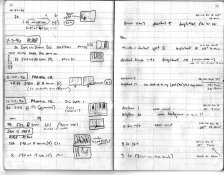TareqPhoto
Member
I would like to know what is your way to write down or noting the details you do with film such as camera used, the film, the developer,....etc.
I created a page with table included, what do you think about it? and what should i change about it?
I want to use this sheet as details recording, i bought a small note but i feel notes aren't that much clear if i mess writing the details and if the note is small, and the writing is taking time for me, but the this kind of sheet i can just fill the blanks to save time for me, give me any suggestions or opinions, please.
Attached 2 versions of the same page details i am looking for, the second one i added lines for notes if i want to write down the steps i did in processing.
I created a page with table included, what do you think about it? and what should i change about it?
I want to use this sheet as details recording, i bought a small note but i feel notes aren't that much clear if i mess writing the details and if the note is small, and the writing is taking time for me, but the this kind of sheet i can just fill the blanks to save time for me, give me any suggestions or opinions, please.
Attached 2 versions of the same page details i am looking for, the second one i added lines for notes if i want to write down the steps i did in processing.







